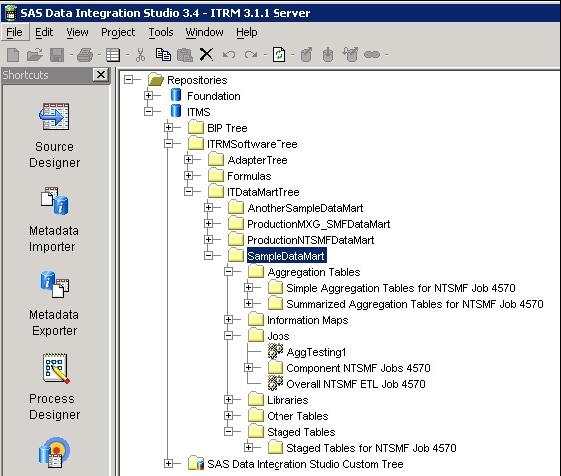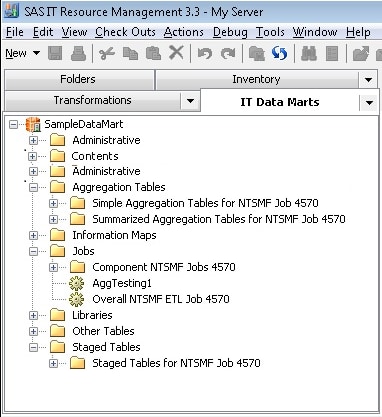Migrating a Single IT Data Mart from SAS IT Resource Management 3.1.1, 3.2, 3.21, or 3.3 to 3.3
Migrating from SAS IT Resource Management 3.1.1 to 3.3
Overview of Migrating from SAS IT Resource Management 3.1.1 to 3.3
In some instances, you
might want to migrate only a single IT data mart from SAS IT Resource
Management 3.1.1 to SAS IT Resource Management 3.3. The Extract311DataMart
and DeployDataMartTo33 tools provide this functionality.
Note: The Extract311DataMart and
DeployDataMartTo33 tools are supported only when migrating IT data
marts between IT Resource Management systems that are hosted on platforms
belonging to the same operating system family. For example, you can
migrate only from Windows to Windows, from UNIX to UNIX, or from z/OS
to z/OS .
These tools support
all objects in an IT data mart except for information maps and formulas.
-
The staged and aggregated tables in the IT data mart that you are migrating from SAS IT Resource Management 3.1.1 might use formulas in the calculation of a computed column. If so, the formulas that are invoked are matched to the formulas that are in the
IT Formulasfolder on the SAS IT Resource Management 3.3 system. The formulas on the SAS IT Resource Management 3.3 system are the formulas that will be used in the calculation of computed columns. (The formulas that are on the SAS IT Resource Management 3.1.1 system will not be applied to the computed column calculations.) Therefore, before migrating your IT data marts, change the formulas on the target SAS IT Resource Management 3.3 system to match the formulas that are used in your SAS IT Resource Management 3.1.1 system. For more information, see Chapter 6, “Formulas,” in the SAS IT Resource Management: Administrator's Guide.
Running the Extract311DataMart and DeployDataMartTo33 Tools Work
The Extract311DataMart
and DeployDataMartTo33 tools are distributed in a JAR file called
Extract311Deploy33.jar. This JAR file can be found in the
deploy subdirectory
of your installed IT Resource Management client. (The default location
of this JAR file is C:\Program Files\SASHome\SASITResourceManagementClient\3.3\deploy.)
Note: When running these tools,
you must use a SAS Administrator user account (typically sasadm@saspw).
This user account has privileges that are associated with the Metadata
Server: Unrestricted role. In addition, the SAS Administrator account
is initially a member of the SAS Administrators group. For more information
about this account, see “Overview
of System Administration User Roles” in
the SAS 9.3 Intelligence Platform: System Administration
Guide.
Before using the extract
and deploy tools, be sure to apply any hot fixes that are available
for this version of SAS IT Resource Management. Hot fixes for SAS
IT Resource Management 3.3 and later are accessible here:
http://ftp.sas.com/techsup/download/hotfix/HF2/H33.html.
-
Move the Extract311Deploy33.jar file to the SAS IT Resource Management 3.1.1 Windows system where your client software is installed. This Windows system will have SAS Management Console, which is part of your source SAS system. (This system does not need to have SAS Foundation installed on it.)Note: If you installed SAS Management Console 9.1 in a location other than the default location, you need to set an SMCCLIENT environment variable. That variable should point to the non-default location before you run the Extract311ITDataMart.bat script. To do so, open a DOS prompt window and issue a
set smcclient =drive:alternate-directorycommand. Here is an example of that command for the SAS 9.1 system:set smcclient=D:\Program Files\SAS\SAS Management Console\9.1
-
In a DOS prompt window, make sure that the
..\binset path=C:\j2sdk1.4.2_09\bin;%PATH%
Then use thejar –xf [jarname]command to unzip the Extract311Deploy33.jar file and place it in a new directory tree. The following example creates a new directory calledExtract, sets the current working directory toExtract, and unzips the JAR file into that directory.mkdir c:\Extract cd c:\Extract jar –xf Extract311Deploy33.jar
-
Note: Before running this Windows batch file, the JAVA_HOME environment variable should be set to the correct Java Virtual Machine (JVM) using the correct version of Java. The supported Java versions for SAS client applications are documented at Third-Party Software Reference. See the section for SAS client applications under the appropriate Service Pack for your SAS 9.1.3 environment.Specify the following positional parameters for the Extract311DataMart.bat program:Here is an example.
Extract311DataMart “SampleDataMart” your311server.domain.com 8561 youruserID yourpasswordThis extract program produces the metadata about the IT data mart that you want to migrate (in XML form). It then writes the extracted files to the directory tree on the SAS IT Resource Management 3.1.1 system. -
If you installed the SAS IT Resource Management 3.3 client in a location other than the default location, you need to set an ITRMCLIENTTIER environment variable. That variable should point to the non-default location before you run the DeployDataMartTo33.bat script. In the DOS prompt window, issue the
set itrmclienttier =drive: alternate-directorycommand. Here is an example of that command:set itrmclienttier= D:\Program Files\SASHome \SASITResourceManagementClient\3.3If you installed the SAS Versioned Jar Repository into a non-default location, you need to set a VJRPATH environment variable to point to the non-default location before you run the DeployDataMartTo33.bat script. In the DOS prompt window, issue thevjrpath =drive: alternate-directorycommand. Here is an example of that command:set vjrpath = D:\Program Files\SASHome\SASVersionedJarRepository\
If you installed the SAS Platform Object Framework into a non-default location, or if you want to use an alternate SAS Java external configuration file, you need to set an EXTCONFIG environment variable to point to the non-default location before you run the DeployDataMartTo33.bat script. (This environment variable should point to a file location rather than a directory location.) In the DOS prompt window, issue theset extconfig =drive:alternate-directory filenamecommand. Here is an example of that command:set extconfig = D:\Program Files\SASHome\sas.java.ext.config
-
Note: Before running this Windows batch file, the JAVA_HOME environment variable should be set to the correct Java Virtual Machine (JVM) using the correct version of Java. The supported Java versions for SAS client applications are documented at Third-Party Software Reference. See the section for Java Runtime Environments under the appropriate maintenance release for your SAS 9.3 environment.Specify the following positional parameters for the DeployDataMartTo33.bat program:Here is an example.
DeployDataMartTo33 your33server.domain.com 8561 youruserID yourpasswordThe IT data mart from the SAS IT Resource Management 3.1.1 system is now available on your SAS IT Resource Management 3.3 system.The messages written by the DeployDataMartTo33 batch file can be captured in the usual Windows method, by redirecting output. Here is an example.DeployDataMartTo33 your33server.domain.com 8561 youruserID yourpassword > deploy.logNote: If you run the DeployDataMartTo33 tool for the same 3.11 IT Data Mart twice, or if another IT data mart already exists with the same name, rename one of them. If one of these IT data marts is not needed anymore, you can delete it. To delete or rename an IT data mart, on the IT Data Marts tree of SAS IT Resource Management, right-click the IT data mart. For more information about deleting or renaming an IT data mart, see “Working with IT Data Marts” in Chapter 4, “Data Marts,” in the SAS IT Resource Management: Administrator’s Guide. -
This step is recommended, although it is optional. Perform this step to ensure that existing SAS IT Resource Management 3.1.1 physical data libraries are not overwritten when the physical data is unpackaged on the SAS IT Resource Management 3.3 system.Note: This step is required if you are migrating between releases of the SAS System (for example, from SAS 9.2 to SAS 9.3).To rename the pathnames and data sets in the metadata for the new SAS IT Resource Management 3.3 IT data marts, use the %RMDMPATH macro. For information, see Step 4: Rename the SAS ITRM 3.1.1, 3.2, 3.21, or 3.3 IT Data Mart Metadata Pathnames and Data Sets for Migration.
-
The Extract311DataMart and DeployDataMartTo33 tools migrate only the metadata that is associated with an IT data mart. To migrate the data from the SAS IT Resource Management 3.1.1 IT data mart to the SAS IT Resource Management 3.3 IT data mart, use the package (%RMDMPKG) and unpackage (%RMDMUPKG) macros.
-
The same folder structure of the original IT data mart is carried over to the SAS IT Resource Management 3.3 system. The following display shows the folder structure of an IT data mart on a SAS IT Resource Management 3.1.1 system.The following display shows the folder structure of a SAS IT Resource Management 3.3 IT data mart, after the Extract311DataMart and DeployDataMartTo33 tools have been successfully run.To upgrade the IT data mart to the SAS IT Resource Management 3.3 data model, run the %RMUPGRDM macro. For information about this macro, see Introduction to the Data Model Upgrade.
Migrating from SAS IT Resource Management 3.2, 3.21, or 3.3 to 3.3
Using the Export and Import Utilities to Migrate from SAS IT Resource Management 3.2, 3.21, or 3.3 to 3.3
To determine which view
of the SAS IT Resource Management client to use to perform the export
and import functions, follow these guidelines:
Export the IT Data Mart to a SAS Package
To export the IT data
mart from SAS IT Resource Management 3.2, 3.21, or 3.3 to a SAS package
that contains the IT data mart and its objects, invoke the Export
to SAS Package wizard from the SAS IT Resource Management
3.2, 3.21, or 3.3 client.
Moving the Data in the Migrated IT Data Mart from SAS IT Resource Management 3.1.1, 3.2, 3.21, or 3.3 to 3.3
After you have migrated
the metadata for your IT data mart from SAS IT Resource Management
3.1.1, 3.2, 3.21, or 3.3 to 3.3, you can move the data to the new
IT data mart. To do so, perform the following steps:
-
On your SAS IT Resource Management 3.1.1, 3.2 or 3.21 system, use the %RMDMPKG macro to package the data. For information, see Step 3: Package Data from SAS IT Resource Management 3.1.1, 3.2, 3.21, or 3.3 IT Data Marts for Migration.
-
On your SAS IT Resource Management 3.3 system, use the %RMDMPATH macro to rename the pathnames and data sets in the metadata for the new SAS IT Resource Management 3.3 IT data marts. This renaming is done so that existing SAS IT Resource Management 3.1.1, 3.2 or 3.21 physical data libraries are not overwritten when the physical data is unpackaged in step 5. For information, see Step 4: Rename the SAS ITRM 3.1.1, 3.2, 3.21, or 3.3 IT Data Mart Metadata Pathnames and Data Sets for Migration.
-
On your SAS IT Resource Management 3.3 system, use the %RMDMUPKG macro to unpackage the physical data that was created in step 3. The physical data should be unpackaged into the SAS IT Resource Management 3.3 IT data marts. If step 4 was executed to rename the pathnames and data sets, then those new names are used in this step. For information, see Step 5: Unpackage the Data from SAS IT Resource Management 3.1.1, 3.2, 3.21, or 3.3 Data Marts for Migration.
-
To upgrade the IT data mart to the SAS IT Resource Management 3.3 data model, run the %RMUPGRDM macro. For information, see Introduction to the Data Model Upgrade.

